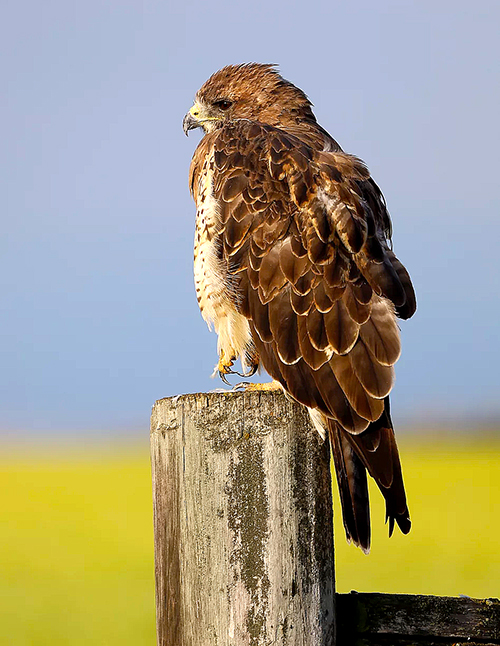'Awareness of nature is the first step to conservation'
Each springtime morning as early as 4 a.m., a choir of tweeting and chirping birds known as the dawn chorus serves as a musical wake-up call — in more ways than one.
“Awareness of nature is the first step to conservation,” says Alexander Hampton, assistant professor in the Department for the Study of Religion. “But it is often limited by all sorts of things, like the boxes we live in and the noise we make, especially in cities.”
This awareness changed during the isolation of lockdown, when the pandemic paused people’s daily lives and heightened the sounds of nature around them, notably birdsong. “During such a difficult time, there was this opportunity to tune into the conversation nature has been having with us all along,” says Hampton.
“But as we continue to move forward, can we hold onto our appreciation of being part of an ecological system — a place where nature continues to live, and even thrive?”
This is the motivation behind The Pleasure of the Dawn Chorus: Preserving the Pandemic Soundscape, an exploration of humanity’s emotional and spiritual connection to nature through the arts. The interdisciplinary project was first conceived in a conversation between Hampton and Nicole Percifield, a doctoral student in the Faculty of Music. It became a collaboration with faculty and students from the Department for the Study of Religion and the Faculty of Music, supported by the Jackman Humanities Institute (JHI).
To preserve the unique urban birdsong that emerged during the pandemic, undergraduate students from Hampton’s courses “Religion and Nature”, “Enchantment, Disenchantment and Re-Enchantment” and “Global Perspectives on Ecology and Religion” recorded the sounds of the dawn chorus all around the GTA — from the University campus to their own neighbourhoods, from public parks to Queen’s Park, some with their phones and others with elaborate equipment. The students identified the birds using the Cornell Ornithology Lab Merlin app and created written reflections and photo essays about their experiences and the meaning of nature awareness.
In lieu of the usual readings, this field assignment prompted second-year undergraduate student Audrey Miatello to look for nature in her own backyard. At first, she says, she wasn’t sure how far she’d have to go to find it: “I spent a long time attentively walking around my neighborhood, listening for chirping sounds. Finally, I came across a tree that was filled with the singing of many birds. Alongside their singing, I could hear the noise of cars and the hum of nearby traffic — an interplay between the natural and artificial parts of our city.”
The next step of the Dawn Chorus project used music to communicate the experience of listening to bird song — “an experience which can sometimes be difficult to explain,” says Miatello.

With the recordings and reflections from students like Miatello as inspiration, Faculty of Music doctoral candidates — mezzo-soprano Percifield, composer Gavin Fraser and pianist Geoffrey Conquer — worked together to create a new musical composition in honour of the dawn chorus.
Translating birdsong into vocal and instrumental melodies first required spectral analysis, a visual interpretation of pitch that applies colour to a particular frequency. In other words, a way to see sound. The pitch analysis allowed the birdsong to be transcribed into musical notation, the raw material that the musicians used to workshop the composition.
“In music, we associate frequencies with pitches which are very fixed, meaning we can pick out particular notes,” Fraser explains. “Birdsong, however, is so complex and not as clear-cut as a vocal melody. The dawn chorus is a beautiful cacophony of all these birds, so instead of picking out specific pitches, we created melodies based on the structural arc of what these pitches look like over time.”
As the composer, Fraser sought to tell the story of the dawn chorus, not necessarily replicate it: “It was more about creating a journey of coming into this world, that humans can understand as the dawn chorus. I wanted to capture this idea on two different levels — a literal waking with the choir of morning birdsong, and ‘waking up’ to the natural world by interacting with it in a respectful way.”
He used several compositional techniques to accomplish this, such as call-and-response between the piano and the voice, and layering different songs of red-winged blackbirds, American robins, chickadees and geese, to name a few. Singing like a bird, in this sense, became more about interpreting the sound.
“We also evoked an environment that feels like it's the early morning, where birdsong would exist — Nicole makes wind sounds, Geoffrey taps on the piano, and I sprinkle in bird-like, melodic elements that then build into harmonies.”
Mezzo-soprano Percifield and pianist Conquer performed the final piece at a recent virtual lecture recital hosted by JHI, bringing nature and humanity quite literally in concert with one another.
“Our feelings of connection to nature are often left unexpressed,” he explains. “The arts enable us to respond to feelings of wonder, enchantment and awe and give them expression, in a way that connects us more deeply to the nature in our own backyards — and in turn, to something bigger than ourselves.”
Hampton also notes that the spiritual aspect of connecting to the natural world — a concept called “ecospirituality” — resonates with people on a broad scale, enabling people from diverse backgrounds to identify with urban conservation meaningfully.
“Some of my students contextualize this sense of wonder within their personal religious traditions — the connection to creation, for example,” says Hampton. “Others connect it to the ecosphere they live in, to nature itself as an object of wonder, which is something they understand in a more secular way.”
Cultivating a relationship with the environment in this way can help remedy what can often feel like an insurmountable level of doom-and-gloom about the state of the planet.

“We have these feelings of anxiety and depression because we feel like we can't do anything about it, but the joy and pleasure of nature is all around us,” Hampton says. “If we create more awareness of that, and then express our connection through sharing music or making art or taking photographs, then that is the first step of conservation.”
“This project helped me realize that nature exists all around us,” says Miatello, a member of Woodsworth College who is hoping to complete a double major in Religion and Book & Media Studies. “With patience and attention, we will see that our neighborhoods are actually home to many natural wonders just waiting to be discovered.”
“Now, months later, I still try to carefully observe nature when I am outdoors, making sure not to miss the small details that can easily be overlooked.”
Building on the success of the Dawn Chorus as a pilot project, Hampton would next like to engage the public by partnering with community organizations and public institutions like conservation groups, schools and museums. He is also curious about branching out into preserving and interpreting other types of soundscapes.
“For instance, Toronto is home to a vast ravine system — what do these rivers sound like? There are a lot of different layers to tune into, and all sorts of things in bioacoustics that one can measure that we don't necessarily register in our own ears, like the sound that trees make,” Hampton explains.
“There is a conversation to be had with nature on its own terms. The Dawn Chorus project brings humans back into that conversation, by listening and responding to non-humans as part of the environment that we all share.”
Original article reproduced in full with kind permission of the author.
Update!
The Dawn Chorus project was the season finale show for CBC Radio's Tapestry arts program → Read/Listen


